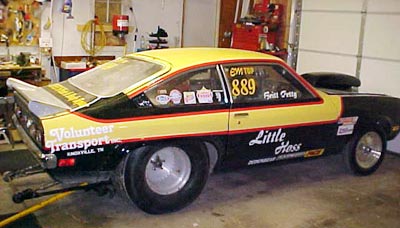|

A project car with a
real-world budget
Words and photos by Jok Nicholson

When I was about halfway through the most successful
magazine project car ever (Project 4-Link),
I was thinking of the number of young racers
that could not imagine having the cash to build
a dragster like we did. It is common knowledge
that most magazine project cars end up being
$40,000 to $60,000, top of the line vehicles.
In today's economy, I feel it is the right time
for a project like I have now started.
"Back-2-Basics" will prove it is possible for
a young racer to get started drag racing in
a safe and fast doorslammer for under $12,500.
That is still quite a bit of money but I wanted
to make this a project that could be a good
bracket car that could run with and without
a delay box as well as be a contender in IHRA's
10.90 Hot Rod class and NHRA's 10.90 Super Street
class. I have always felt the more adaptable
the car is, the more fun you can have with it.
To that end, I started looking for the right
car to get Back-2-Basics started.
I began by reading every printed want ad I
could get my hands on, looking for what I felt
would be a fun car to drive and affordable.
I knew it had to be a used racecar because constructing
even a basic doorslammer from scratch would
blow right over the budget I had. I looked at
hundreds of ads and sent out tons of email to
racers who were advertising their cars. I came
to this conclusion after two months: If it is
a Camaro and is a "roller" (meaning everything
but engine and transmission) it will probably
bring about $8,500 to $12,500 depending on how
nice it is.
Mopar and Fords can be found for about $1,500
less, due to less demand I think. I found all
sorts of nice Novas and Camaros "turn key",
with engine and transmissions, from $12,000
to about $16,000. There were plenty of Demons
and Dusters that were turn key in the $10,500
to $15,000 range. I found some terrific cars
out there and if you are looking here are a
few sites I went to when I was looking: www.racingjunk.com;
www.dragraceresults.com;
www.classracer.com;
www.superstockforum.com;
There are probably more out there but this is
a strong selection.
A lot of you who read my Dead-On column know
I have always been a Mopar guy. Well, that has
changed! My final decision was down to three
cars: a '65 Mustang set up for big block Chevy
and 'glide; a '72 Vega set up for small block
and 'glide; and a '69 Dart set up for small
block Mopar and 'glide. My final decision was
made easier when it seemed they all had about
the same basic equipment, they all needed some
TLC (garage time) and they were proven cars.
I chose the one that cost the least, weighed
the least and would have the lowest priced parts
I needed: the 1972 Vega.
A lot of my friends--and my wife too--thought
I was nuts for buying a car without seeing it
in person. I did not feel that way. In talking
to the guys I bought it from they came across
as very down to earth and nice guys. They gave
references I could call to ask about the car
or people in town that knew them. We reached
an agreed price and I sent a $500 deposit. Balance
would be paid in cash upon delivery. Another
selling point was that the guys I bought it
from were from eastern Tennessee and they said
for the car price of $5,000 they would deliver
it to me! That is 13 hours one-way so that saved
me hundreds of dollars in gas not to mention
vacation time I want to save for racing. I did
buy the delivery guy and his mother a great
steak at a small "grill your own" steakhouse
here in Janesville, Iowa.
NEXT
PAGE >>
|